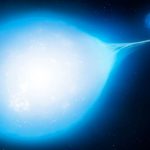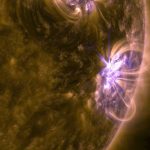An international team of astronomers known as the “black hole police” have discovered a dormant black hole located right next to the Milky Way.
The team, including Kareem El-Badry of the Harvard-Smithsonian Centre for Astrophysics – himself nicknamed the “black hole destroyer” – is famed throughout the astronomy community for debunking new discoveries of gravitational singularities.
However this time they found one for real, a rare dormant black hole revealed by observations of the Tarantula Nebula, part of the Large Magellanic Cloud, our nearest galactic neighbour.
“For the first time, our team got together to report on a black hole discovery, instead of rejecting one,” said Dr Tomer Shenar, a Marie-Curie Fellow at Amsterdam University, who led the study which has been published in the prestigious journal Nature Astronomy.
Dr Sehnar’s team found the black hole had been born from a star which vanished without any sign of a powerful explosion – “a needle in a haystack” as he described it.
While scientists have proposed similar black hole candidates, the team believe this is the first “dormant” stellar-mass black hole to be unambiguously detected outside of the Milky Way galaxy.
Dormant black holes don’t emit high levels of X-ray radiation, which is normally how they are detected.
Family plans to send 11-year-old boy’s ashes to moon to fulfil his dream of travelling to space
Astronomers detect strange ‘heartbeat’ signal billions of light-years from Earth
A dying star and a ‘cosmic dance’: Ancient galaxies revealed in never-seen-before telescope pictures
Stellar-mass black holes form when massive stars reach the end of their lives and then collapse under their own gravity.
In binary star systems, this process can leave behind a black hole orbiting in a dance with a luminous companion star – and that is what the team believe they found thanks to observations obtained by the European Southern Observatory’s (ESO’s) Very Large Telescope (VLT).
It is at least nine times the mass of our own Sun and orbits a hot, blue star weighing 25 times the Sun’s mass.
Read more:
Two pictures of Jupiter leaked by James Webb Telescope team
Astronomers detect strange ‘heartbeat’ signal billions of light-years from Earth
“It is incredible that we hardly know of any dormant black holes, given how common astronomers believe them to be,” explained co-author Pablo Marchant of KU Leuven.
“For more than two years now, we have been looking for such black-hole-binary systems,” added co-author Julia Bodensteiner, a research fellow at ESO in Germany.
“I was very excited when I heard about VFTS 243, which in my opinion is the most convincing candidate reported to date.”
“The star that formed the black hole in VFTS 243 appears to have collapsed entirely, with no sign of a previous explosion,” explained Dr Shenar.
“Evidence for this ‘direct-collapse’ scenario has been emerging recently, but our study arguably provides one of the most direct indications. This has enormous implications for the origin of black-hole mergers in the cosmos.”
The team say that despite their nickname of being the “black hole police” they actively encourage scrutiny of their study, which has been peer-reviewed.
They hope it will help other astronomers discover similar stellar-mass black holes orbiting massive stars – thousands of which are predicted to exist both in our galaxy and the Magellanic Clouds.
“Of course, I expect others in the field to pore over our analysis carefully, and to try to cook up alternative models,” Dr El-Badry says. “It’s a very exciting project to be involved in.”






















